ASRock's High-End Vision 3D HTPC Reviewed
by Ganesh T S on October 3, 2010 10:20 AM EST
The Vision 3D is basically a notebook solution at its core. It wouldn't make sense to compare it with full blown Clarkdale HTPCs (or for that matter, any system with a power consumption of more than 100W). In the comparative benchmarks provided in the rest of this review, we will provide the scores obtained by the Vision 3D and other notebook solutions. Prior to those, let us look at some of the specific features of the Vision 3D.
USB 3.0 Performance
In the Core 100 review, we had pointed out the fact that the H55M chipset does not provide support for full USB 3.0 performance without a PLX bridge chip. As the Vision 3D caters to the high end market, it would have made sense for ASRock to incorporate this into the motherboard. Unfortunately, they decided to increase the number of USB 3.0 ports instead of aiming to obtain full performance from the pair of ports provided by the NEC controller.
We hooked up OCZ's Enyo 128 GB USB 3.0 external SSD (which has received glowing reviews everywhere with upto 200 MBps read and 190 MBps write speeds) to the various USB 2.0 / 3.0 ports of the Vision 3D (and also repeated the tests with the Core 100).
The OCZ Enyo on the Fresco Logic USB 3.0 Port of the Vision 3D
Using the Random Access feature of HD Tune Pro 4.50, we obtained the average read and write speeds for random sized accesses to random locations on the SSD. The performance metrics are graphed below. Note that the entries against the USB 3.0 ports of the Core 100 differ from those in the Core 100 review, because those were maximum transfer rates as opposed to the average rate presented here.
Click to enlarge
At the outset, it is clear that the USB 3.0 performance improves when compared with the Core 100. This is probably due to the faster i3-370M CPU. An additional interesting observation is that the read and write performance are very similar for the Fresco Logic port. The NEC ports excel at providing read bandwidth, but lose out to Fresco Logic on the write side. Despite these performance numbers, we feel that the third USB 3.0 port is an overkill for the Vision 3D. ASRock could have used the cost premium of this feature towards something more attractive for HTPC users like a SSD boot drive for the OS.
Windows Experience Index
The Core 100's Windows Experience Index was bottlenecked by the Arrandale iGPU. With that going out of the picture, what can hold back the performance of the Vision 3D? Let us look at the Windows Experience Index to get a general feel of the performance that a user can expect out of the machine.
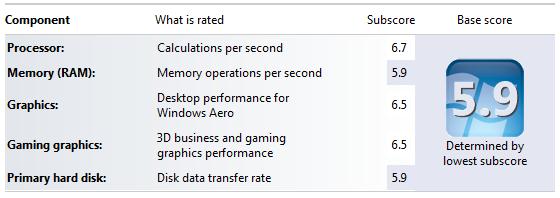
The primary hard disk and the DRAM seem to be slowing down the system. While the DRAM can be overclocked, nothing can probably be done with the primary hard disk (short of replacing it with a SSD). Unfortunately, the Scorpio Black is the fastest 500 GB 2.5" drive in the market right now, and ASRock could probably have not chosen a better drive.
Miscellaneous Performance Metrics
The graphs below give an idea of where the Vision 3D would stand from a performance perspective when compared with some popular notebook computers. PCMark Vantage's PCMark score gives a general idea of the system's capability. In addition to that, a couple of common HTPC workloads are also benchmarked. We have some data on the x264 encoding performance using the Arrandale CPU. An estimate of how well WinRAR performs, particularly with respect to processing split archives, wraps up this section. Since these are CPU-centric benchmarks, it comes as no surprise that the Vision 3D scores better than the
It can be seen from the above benchmarks that the Vision 3D loses out only to its higher clocked and higher core count cousins with respect to CPU-centric benchmarks. There is no doubt, however, that it provides better performance than the mid-range Core 100.
Starting with this review, we will add a WinRAR benchmark for HTPCs. While there is a built-in benchmark to measure the compression speed, it relies on the capabilities of the CPU, DRAM and caches only. Many HTPC users also spend quite some time decompressing split archives. To evaluate this, we take a 4.36 GB MKV file, compress it in the 'Best' compression mode into a split archive (97.1 MB each), which results in 44 files on the hard disk. The time taken to decompress this split archive is then recorded. The performance in this benchmark is heavily influenced by the hard disk in the system. While both the Core 100 and Vision 3D scored similar results in the built-in benchmark (1525 KBps for the Vision 3D and 1452 KBps for the Core 100), the former took 329 seconds to process the split archive, while the latter only took 173 seconds for the same. Starting with the next HTPC review, we will be presenting comparative results for this benchmark in the form of a graph.
In the next couple of sections, we will look at some GPU benchmarks.


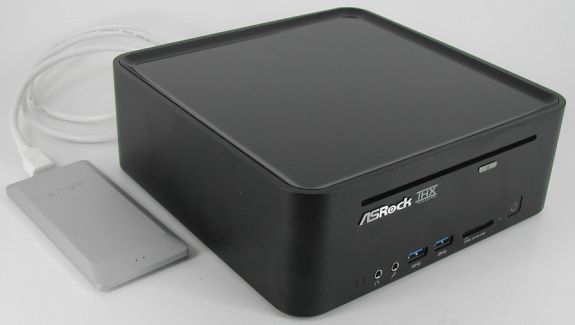
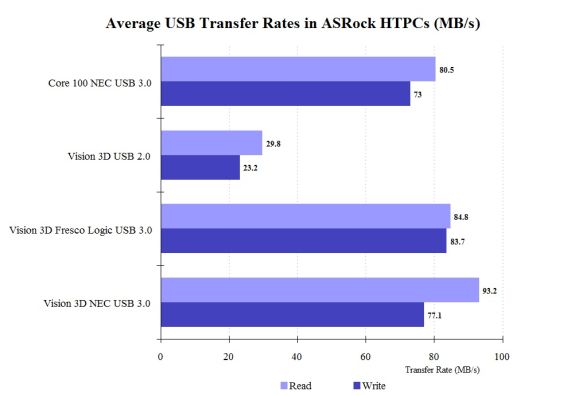
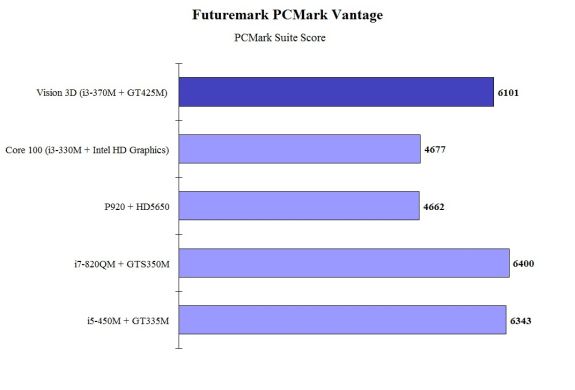
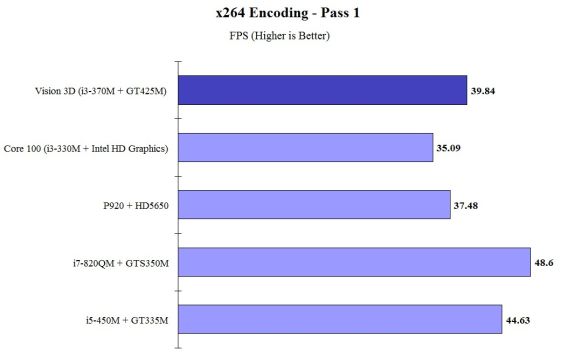
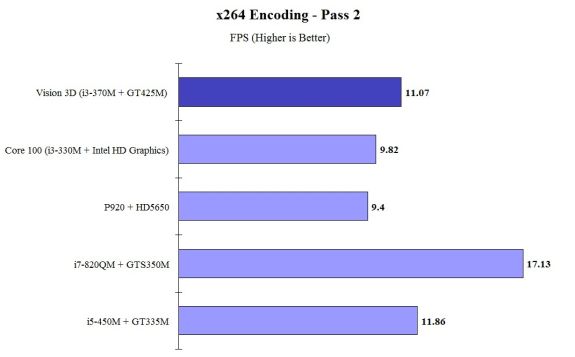








51 Comments
View All Comments
ganeshts - Sunday, October 3, 2010 - link
Thanks, fixed :)nitrousoxide - Sunday, October 3, 2010 - link
A Seagate Barracuda Momentus XT 500GB would do much better job than WD Scorpio Black.LtGoonRush - Sunday, October 3, 2010 - link
A Seagate Momentus XT 500GB would cost nearly twice as much as the WD Scorpio Black 500GB ($130 vs $75 at retail), and the performance difference is rather unimpressive. In the tests where the Seagate can make use of its SLC cache it can take the lead, but in most tests the Scorpio Black is faster, especially when seek times or write performance come into play, since those are Seagate's major weaknesses.BansheeX - Sunday, October 3, 2010 - link
Cool box but LOL at the THX logo being slapped on it. They used to put that on heavily compressed DVD mixes, not all of them good either. Consumers don't care anymore.ganeshts - Sunday, October 3, 2010 - link
Personally, I don't care too much about the THX either :) If you are using HDMI for audio, it doesn't even appear in the picture.The internal audio codec is advertised with THX, so the HTPC using it gets the additional marketing point too :)
tobrien - Sunday, October 3, 2010 - link
you guys did such an excellent job with this review! thanks for all the hard work and effort you guys put in!Shiitaki - Sunday, October 3, 2010 - link
I'm not seeing the value here. A thousand dollars to stream content, and play blurays? One of the previous replies you stated that there was no native bluray support for the mac mini, true. And there is for a machine running windows? Tacking on Cyberlink is not native support.That is way too much hardware for what it does, which illustrates how badly Windows is for a platform. You could do much better with less hardware. Which is the real problem with a htpc, the software, the operating system, and various codecs, and getting it to all work together. Too much complexity. Most of the processor is wasted on layers of software instead of doing actual work. Most of the effort is expended to compensate for lazy and inadequate programming, as well as DRM.
I understand the concept, I had a htpc for a couple of years, but after the frustration of trying to get surround sound to work in Cyberlink for Blurays, and the tech support to keep Windows working, I gave up. In fact it was specifically windows deciding to rebuild my music library from scratch every time I opened media center to play music. I want an appliance on the other end of the remote, having to search forums and break out a mouse and keyboard to trouble shoot something that worked the day before just fine should not be step two after pressing the power button.
In the the article, there is no details as to how much or little work it took to make the software environment to work. Did settings hold, did you have to do reconfigurations, update drivers, load codecs? I seriously doubt it worked out of the box. Working out of the box is the great failure of the pc industry. On the video quality you are hedging, saying that video quality will get better with driver updates? So it's not finished eh? That's the sad reality with the computer industry in general, nothing ships as a finished product.
The only thing this device seems to offer are endless possibilities to reward owners with a sense of accomplishment having solved issues preventing operations promised by the vendor. You can buy a nice bluray player, wd live, and still have 700 dollars for something else.
The real news is if you took it out of the box, plugged everything in, did a setup once, and spent the rest of the time using it. No drivers, patches, settings that reset themselves, or promises of a future update for something to work So what did it take to make it work like it's supposed to, what issues does it have? Did you listen to two channel, or full surround? How many error messages did you have to deal with?
ganeshts - Monday, October 4, 2010 - link
What you are looking for is a player like the upcoming Netgear NTV550. That would put it in the media streamer section. That would be like $700 cheaper than the Vision 3D, but, with the NTV choice, you are at the mercy of Netgear for firmware updates in case something you want doesn't work, and it also doesn't support 3D -- which is what this product is targeted towards.. For the Vision 3D running Windows, you have a number of open source developers who can enable core features like HD audio bitstreaming etc. -- Try getting open source devs to get those sort of features working on a SoC based device.The fact with the HTPC scene is that you do have to do some setup of sorts and deal with error messages and what no. However, sometimes, slapping on the latest XBMC build solves most problems. Our test suite is designed to give problems to various softwares, so deriding drivers / softwares on the basis of the difficulty in getting it to work is not the purpose of the review.
ggathagan - Monday, October 4, 2010 - link
Everything you state is true but, unfortunately, that can be said of computers in general. It's not limited to HTPC.You're also missing one of the major points of the HTPC: Its ability as a computer.
You don't get that from a standalone device.
You don't specify what version of MCE you were using, but if you weren't using the Windows 7 version it's not really a valid arguement.
I never tried the Vista version, but the Win 7 version has certainly come a looong way from the XP version.
And if you happen to be someone on a budget that wants to do it all with a single device, the price of the ASRock system is pretty attractive, even after adding the cost of the OS, monitor and BD software.
Hrel - Monday, October 4, 2010 - link
Pretty sure the hybrid Seagate Momentus XT is the fastest 2.5" drive they could have chosen. To all the other people talking about this egregious error, WD and Seagate are the only mechanical disk hard drive manufacturer's even worth looking at.